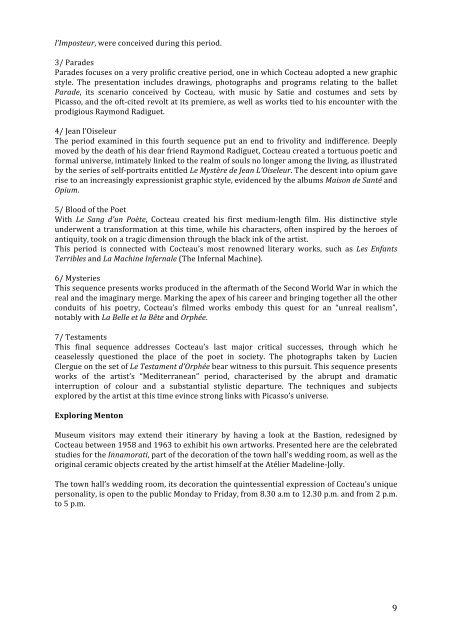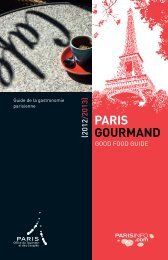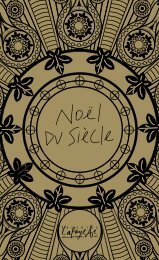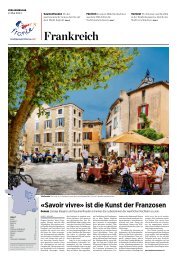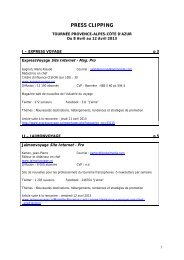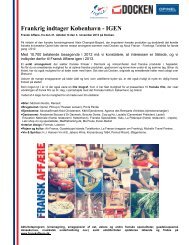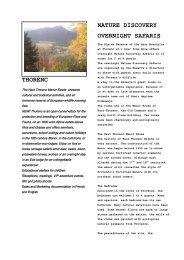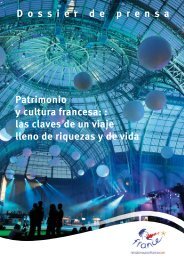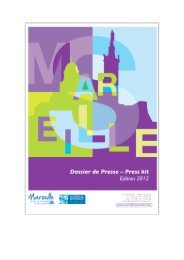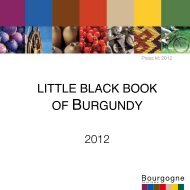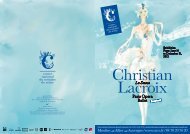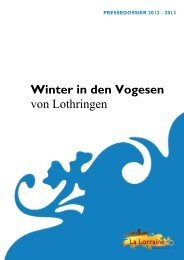DP MJCCSW 4.10_EN - copie - Maison de la France
DP MJCCSW 4.10_EN - copie - Maison de la France
DP MJCCSW 4.10_EN - copie - Maison de la France
Create successful ePaper yourself
Turn your PDF publications into a flip-book with our unique Google optimized e-Paper software.
l’Imposteur, were conceived during this period.<br />
3/ Para<strong>de</strong>s<br />
Para<strong>de</strong>s focuses on a very prolific creative period, one in which Cocteau adopted a new graphic<br />
style. The presentation inclu<strong>de</strong>s drawings, photographs and programs re<strong>la</strong>ting to the ballet<br />
Para<strong>de</strong>, its scenario conceived by Cocteau, with music by Satie and costumes and sets by<br />
Picasso, and the oft-‐cited revolt at its premiere, as well as works tied to his encounter with the<br />
prodigious Raymond Radiguet.<br />
4/ Jean l’Oiseleur<br />
The period examined in this fourth sequence put an end to frivolity and indifference. Deeply<br />
moved by the <strong>de</strong>ath of his <strong>de</strong>ar friend Raymond Radiguet, Cocteau created a tortuous poetic and<br />
formal universe, intimately linked to the realm of souls no longer among the living, as illustrated<br />
by the series of self-‐portraits entitled Le Mystère <strong>de</strong> Jean L’Oiseleur. The <strong>de</strong>scent into opium gave<br />
rise to an increasingly expressionist graphic style, evi<strong>de</strong>nced by the albums <strong>Maison</strong> <strong>de</strong> Santé and<br />
Opium.<br />
5/ Blood of the Poet<br />
With Le Sang d’un Poète, Cocteau created his first medium-‐length film. His distinctive style<br />
un<strong>de</strong>rwent a transformation at this time, while his characters, often inspired by the heroes of<br />
antiquity, took on a tragic dimension through the b<strong>la</strong>ck ink of the artist.<br />
This period is connected with Cocteau’s most renowned literary works, such as Les Enfants<br />
Terribles and La Machine Infernale (The Infernal Machine).<br />
6/ Mysteries<br />
This sequence presents works produced in the aftermath of the Second World War in which the<br />
real and the imaginary merge. Marking the apex of his career and bringing together all the other<br />
conduits of his poetry, Cocteau’s filmed works embody this quest for an “unreal realism”,<br />
notably with La Belle et <strong>la</strong> Bête and Orphée.<br />
7/ Testaments<br />
This final sequence addresses Cocteau’s <strong>la</strong>st major critical successes, through which he<br />
ceaselessly questioned the p<strong>la</strong>ce of the poet in society. The photographs taken by Lucien<br />
Clergue on the set of Le Testament d’Orphée bear witness to this pursuit. This sequence presents<br />
works of the artist’s “Mediterranean” period, characterised by the abrupt and dramatic<br />
interruption of colour and a substantial stylistic <strong>de</strong>parture. The techniques and subjects<br />
explored by the artist at this time evince strong links with Picasso’s universe.<br />
Exploring Menton<br />
Museum visitors may extend their itinerary by having a look at the Bastion, re<strong>de</strong>signed by<br />
Cocteau between 1958 and 1963 to exhibit his own artworks. Presented here are the celebrated<br />
studies for the Innamorati, part of the <strong>de</strong>coration of the town hall’s wedding room, as well as the<br />
original ceramic objects created by the artist himself at the Atélier Ma<strong>de</strong>line-‐Jolly.<br />
The town hall’s wedding room, its <strong>de</strong>coration the quintessential expression of Cocteau’s unique<br />
personality, is open to the public Monday to Friday, from 8.30 a.m to 12.30 p.m. and from 2 p.m.<br />
to 5 p.m.<br />
9


